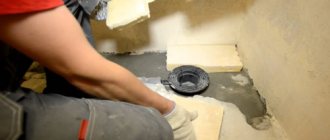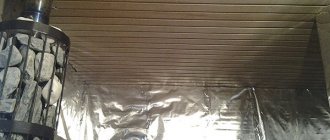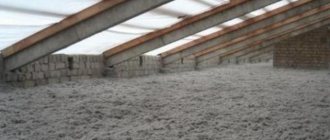Convection in the steam room, the organization of this process is the most important factor influencing the microclimate of the steam room.
The steam room has a Vulcan stove.
Previously, a brick screen was built around the stove made of ordinary stove bricks with large gaps measuring 3/5 of a brick. 3 hours after the start of heating, the floor temperature increased from 20 to 35-40 degrees.
After the overhaul, several changes were made.
1. The ventilation space “2” is blocked quite tightly using a strip of LSU - see the diagram of the furnace.
A layer of small stones is densely poured onto the LSU strip, thus sharply limiting convection.
2. Screen - front part with vertical slits of 1 cm, left - blank, right - blank with two half-brick windows. The brick is facing, with holes filled with sand.
1. Before the overhaul, the steam room accelerated to 100-110 degrees, now - no more than 75-85 degrees.
2. The floor temperature practically does not increase - after 4 hours no more than 25 degrees.
Increasing convection in a purely mechanical way - we place a fan at the inlet ventilation hole with the openings in the sarcophagus open.
Air flow direction
I analyzed the direction of air flows in the steam room using a candle. I checked it during the heating stage of the steam room. Several conclusions.
- 1. My furnace is the pump for ventilation, not the metal air duct.
- 2. During the warm-up stage, it is advisable to close the ventilation. The convection of internal air in the steam room is definitely reduced.
- 3. The size of the “windows” in the brick screen determines the temperature of the air flow between the metal screen of the furnace and the brick one. In the absence of windows - the lowest temperature, with “large windows” - hotter air, with “narrow windows” - in the form of vertical slits - the highest temperature.
- 4. Floor heating is related to the height of the “windows” from the base of the stove.
- 5. The most powerful air flow is provided by a new screen around the pipe made of thin-walled tubes. The candle flame just goes wild.
Covering the stove with a brick screen with the right convection channels in it, or a massive volumetric stone backfill = up to 180 kg, as in the Harmony stove, allows you to get very pleasant heat from the stove after finishing the heating of the “metal” and, most importantly, guarantees drying of the steam room.
Convection in the steam room at the heating stage of the bath is very useful. It is due to convection, without overheating the ceiling, without making the stove and pipe red hot, that we can evenly mix the air in the steam room and warm it up.
Try heating a log house covered with clapboard simply by radiation without convection. Tested together with Vladimir Lyakhov - and it won’t work in 4-5 hours.
And now the steam room is ready - heated to 60 degrees, or higher - up to 100.
We close the convection channels in the brick screen, in the convector chimney - and have a great steam bath.
Fans of “sauna” modes play with convection.
There is an accordion, there is a button accordion, and there is a concert button accordion with registers. Each Master chooses a tool for himself.
Some steam lovers perceive a visit to a Russian bath as an excellent relaxation for the body, others - as a way to prevent many diseases. Indeed, regular trips to the steam room strengthen your health and immunity, if there are no contraindications.
However, real comfort for vacationers is ensured only when the stove for the Russian bath is chosen correctly - moderately powerful, efficient, and safe. In this article, we will look at the best factory-made models that are current and have won consumer recognition. We will also dwell on the criteria for choosing a suitable model.
Finnish sauna
Minimum humidity and dry hot steam.
The oven temperature can reach up to 110 °C with humidity in the steam room not exceeding 20%. At the same time, in addition to conventional wood-burning stoves, electric stoves (electric heaters) are also used in saunas.
Sitting time in the steam room is no more than 10 minutes. Then rest is needed, usually a swimming pool is chosen for this purpose, and then again enjoy the hot steam. The head is wrapped in a dry towel to avoid heat stroke, and the shelves are also covered so as not to burn the skin.
After visiting the sauna, blood circulation improves, the lungs are ventilated and pathogens are destroyed.
Contraindications for visiting are the same as for a Russian bath.
3
TOP 10 best sauna stoves
Wood heating has a relatively low efficiency, but bathhouses, especially in the North, are still usually heated with logs. For this reason, we have compiled a rating of wood-burning models.
The TOP includes stoves from well-known manufacturers that sell well and have many positive reviews.
Place #1 – Harvia M3
The Finns are real pros in the production of high-quality equipment for baths and saunas, and the M3 model is another confirmation of this. Occupying a small area on the floor, the heater for a Russian bath has a vertically elongated body, so it evenly warms the room.
A special open compartment is loaded with 30 kg of stones, which must be purchased separately. The design is designed in such a way that maximum heat transfer occurs and the stove remains hot for a long time.
The oven is compact and has a nice design. The body is painted in neutral colors – black and steel. The paint is heat-resistant and does not lose its protective qualities and appearance over time. Flames are visible through the heat-resistant glass.
- installation method: wall-mounted;
- heating power – 16.5 kW;
- material of manufacture – steel/glass door;
- designed for volume – 6-13 m³;
- firebox - without removal;
- water circuit - no;
- heater – open, 30 kg.
According to reviews, the stove is beautiful, economical and quickly warms up the room. Although it is not intended for connecting a water circuit, it can be supplemented with a water tank, which is purchased separately and mounted in the pipe. If you need a water heating circuit, we recommend that you familiarize yourself with the rating of the best furnaces with a water circuit.
The negative point is low efficiency, only 67%. The ash removal scheme has not been thought through - during operation and during cleaning, some of it ends up on the floor.
Operating rules
The manufacturer recommends heating new sauna stoves for 60 minutes with windows and doors open to completely remove the paint smell. When using for the first time, load the firebox completely, fill the water tank, and leave the heater empty. This is necessary to burn out the technical lubricants and products used in production.
After the stove has cooled, the water is drained, the bathhouse is ventilated, and stones are filled in. The oven is ready for use.
During further operation, you need to follow a number of the following recommendations:
- make kindling with small, dried wood chips 2/3 of the volume;
- put firewood on the grate;
- do not burn paints and varnishes or tires in the firebox;
- after half of the wood has burned out in the stove, good draft is formed, at this moment you should add 2/3 of the wood to the firebox and open the ash pan;
- when the bathhouse warms up, close the ash pan, throwing logs into the firebox from time to time to maintain heat;
- At the end of the bathing procedures, the stove is heated again to dry the room.
Criteria for choosing a wood stove
Usually the stove is selected for the steam room, taking into account the volume/power ratio. But design also plays a big role: some like rounded, high-tech designs with heat-resistant glass, others like rough cast-iron cases with embossed doors.
But it is better not to be guided by any one aspect, but to consider all the technical characteristics and design features of the unit. We suggest considering several criteria before choosing and purchasing a stove for a wood-burning sauna.
Choosing a stove for a home bath or sauna is not easy, especially since some selection criteria are not entirely obvious. In this article we will talk about how to correctly calculate and choose a stove for a sauna, what types and design features of stoves there are, and which purchase is exactly right for your steam room.
When choosing a stove, you need to take into account absolutely all factors: both purely technical and those related to ease of use. Everything matters: from the material of the walls of the bathhouse to the mode of use and the number of people visiting it.
User Questions
During operation of the Taman 10 stove, smoke began to emerge from the door. What to do and what is the reason?
Problems with traction. You need to clean the chimney from the roof side with a hard metal brush. Clean the furnace manifold through the structural gap on the side of the fuel channel using a flat metal object.
The factory recommends a distance between the control panel and the gas burner of no more than 1 m. Is it possible to increase this distance to 2 m?
The length of the conductor from the thermal cylinder to the thermostat is 1 m. You can increase the distance from the burner to the control unit and, accordingly, change the installation location of the thermal cylinder in a steam room only by extending wires with an electrical contact (Ev2 or network wire). It is impossible to extend the thermal bulb and its tube, since there is freon inside. You can try replacing the entire thermostat with a longer thermostat wire.
There is a gap in the area of the smoke collector ring and the sandwich mesh fastening. Can sealant be used?
The outer diameter of the smoke collector ring on sauna stoves is 112.9 mm, the inner diameter of the sandwich mesh is about 116 mm. Therefore, there is a gap of about 3 mm during installation. It is a design feature and does not need to be sealed. If the gap bothers you for some reason, you can seal it with heat-resistant sealant or silica cord.
When installing the stove and screen below, a “gap” or through hole is formed between the steam room and the adjacent room. Should it be like this or should I cover it with something?
This is how it should be, it is necessary for the convection of the oven in the steam room. You can cover it, but not tightly. You can use any non-flammable material (ceramics, metal).
Does the mesh convector in a Bugrinka 16 T. oven with a large load of stones affect its service life?
No. A mesh convector with a large mass of stones does not affect the service life of the stove.
I severely peeled off the paint on the Rus stove in a couple of places. What paint is used for painting and where can it be purchased?
For painting stoves, heat-resistant paint such as “Certa” is used. A can of spray paint can be purchased from the same store where you purchased the stove. In order for the paint to set, after touching up the stove will need to be heated, and a smell may appear, which will subsequently disappear.
Does the Sahara stove have one hole for the chimney or can the pipe be moved closer to the back wall of the stove?
The chimney outlet in Sahara stoves is located in the center of the heater. This arrangement was chosen specifically - it simplifies the installation of the chimney and does not affect the ergonomics of the stove - it is convenient to use the heater.
Features of the tunnel firebox
Choosing a stove design for a bath begins with determining the type of firebox; it can be regular or remote (tunnel, elongated). The last option is optimal if there is a suitable adjacent room next to the steam room from which you can lay firewood.
Stoves with a conventional firebox are not so convenient; they steal precious oxygen from the steam room and disrupt heat exchange, attracting fresh cold air. In addition, there is no place for firewood and logs in a clean steam room.
If you plan to heat a remote firebox from the recreation room, pay attention to stoves with a fireplace-type door. It will fit perfectly into the decor of the room and will give an incomparable presence of living fire.
The most popular tube heaters
The most popular models of tube convectors are Termofor units. There are two types of devices available:
- chimney-convector 1, which can heat only one room;
- chimney-convector 2 for heating two adjacent rooms.
Chimney-convector - for adjacent rooms
Termofor consists of several pipes that have standard sizes - 0.65 m or 1 m. The diameter of the internal part is 115 mm, and the outer casing is 220 mm.
Termofor 1 consists of two pipes, which are equipped with decorative overlays. The model for heating several rooms has an angular shape. Transform 2 is equipped with a set of four pipelines and linings.
This installation is similar in principle to a coaxial pipe. To increase the productivity of the unit, an additional air duct is installed on the convector pipes. It improves air circulation inside the unit.
Number of stones, heater type, setting
The highest quality steam in a bathhouse is called light. It is formed at temperatures above 500 °C, when water has time not only to heat up, but to disintegrate into molecules. But if the oven heats up to such a temperature, the air inside the room will be very hot, so stones are used to generate steam.
There are two types of heaters and each has its admirers. A closed heater with direct heating is typical for a Russian bath and it is rare to find an iron stove with it. Much more popular are stoves with an open heater, in which it is more difficult to generate steam and much more stones are needed.
The number of stones that can be placed in the stove heater is determined by the manufacturer, based not on the power of the stove, but on the design features. But it is better to calculate the weight of the stones yourself, based on the principle of 15 kg for each cubic meter of the bathhouse, plus 15 kg for each visitor.
Finding a stove with suitable power ratings and the number of stones is not the easiest task. As a last resort, you can increase the volume of the open heater by constructing a side fence for the stones yourself. But be sure to take a reserve of furnace power, based on the calculation: 1 kW per 25 kg of stone.
comparison table
| Type of oven | Heat | Cooling down | Fuel consumption | Price |
| Cast iron | 30-40 minutes | 30-40 minutes | 4.4 kg/h | from 15 thousand rubles |
| Steel | 15-20 minutes | 10-15 minutes | 6-7 kg/h | from 16 thousand rubles |
| Electric | 10-15 minutes | 15-20 minutes | 3-6 kg/h | from 25 thousand rubles |
| Brick | 2-3 hours | 10-15 hours | 6-9 kg/h | from 15 thousand rubles |
Steam generator or combined heater
In some stoves, the heater is present only for appearance: steam generation occurs in a system of closed channels laid inside the outer casing. The temperature in them exceeds 600 °C and the steam is really “light”.
But not all manufacturers implement this feature correctly. In most cases, the steam generator fails after a couple of years of active use - scale formation has not been canceled.
Partially, both approaches are well combined by a combined heater, in which water is first supplied to the stones with direct heating, and the resulting steam becomes dispersed, already passing through the open stones.
Varieties
There are many types of heater stoves. In fact, any stove can be classified as such if it is equipped with a compartment for placing stones. Furnaces are divided according to different criteria.
First of all, by type of firebox:
brick
steel
cast iron
combined
- Brick ovens are safe and easy to use. However, they require a long warm-up period, which means high fuel consumption. At the same time, a heated brick oven is able to retain heat for a long time, which is not observed when using metal ovens.
- Metal stoves , on the contrary, heat the room quickly and economically. However, they cool down just as quickly, and only a massive heater can stop this process.
- Combination stoves are a combination of a cast iron or steel firebox with a brick body, or a brick firebox on which a steel water tank is installed and a compartment for stones on the side. This design option is very common.
By type of heater:
open
The stones are in plain sight (laid in a mesh or basket made of steel strips);
closed
The stones are located in a closed section. Access to them for water supply is made through a special hatch or door.
It is generally accepted that open heaters produce more humid steam, and closed heaters produce drier steam.
By fuel type:
wood (or solid fuel)
gas
electric
liquid fuel
The traditional option is a wood stove. However, in terms of efficiency and heating speed, a gas furnace is the leader.
Electric designs practically do not lag behind gas ones - they do not require monitoring and constant supply of fuel, and allow you to precisely adjust the heating mode. However, in regions with expensive electricity, the use of heating elements costs too much.
Liquid fuel stoves are powered by hydrocarbon fuel compositions - gasoline, diesel fuel, kerosene, etc. They are quite effective, but the fuel will have to be stored somewhere, which in itself requires special measures.
By operating mode:
long burning
As a rule, these are brick ovens that can be fired continuously as long as fuel is available;
periodic combustion
Typically, these are metal stoves (steel or cast iron), which are heated only for a certain time.
The first group of stoves is characterized by durability and the ability to accumulate and gradually release heat, ensuring uniform heating of the room. The second group is valued for its ability to quickly warm up the room and save time for the bathhouse owner. However, after the end of the kindling, the temperature in the bathhouse quickly drops.
The correct material and design of the sauna stove
The ideal option for the walls of the firebox and stove is cast iron. It does not burn out and has a high heat capacity. But, unfortunately, it is rare. Cast iron was replaced by chrome-plated stainless or alloy steel. They have a very high temperature of scale formation, but the heat capacity is significantly lower. In most modern stoves, only grates are made of cast iron, and you need to pay attention to their shape: the grate must support uniform combustion of fuel, even of low quality.
The firebox and main heat exchanger of a good stove must be made of high-quality steel with a chromium content of at least 13%. Preference should be given to the presence of stamped elements, although joining parts by high-quality welding, especially by the plasma method, is not much inferior. The presence of additional fins inside the firebox and chimney channels is a good sign, as heat from the flame is transferred faster.
The efficiency of the furnace largely depends on the presence of internal channels that impede and prolong the passage of gases and flames, which allows more heat to be obtained with minimal soot formation. In this case, additional heat exchangers are rationally placed above the heater, where the smoke is not hot enough to heat the stones.
Made from stainless steel
Many people choose this option, since there is no need to have specialized skills. No welding is required during installation. It is advisable to take food grade stainless steel, which is resistant to aggressive environments and high temperatures. The material will last a long time. To create a stainless steel chimney, perform the following steps:
Chimney-convector:
With this device, the air will flow through the central pipe, heating the flows entering the pocket. They will come out hot. When installing any economizer, you need to remember the general recommendations:
If you don’t have time to create a device yourself, then you can always choose a ready-made suitable option on the market. But you must definitely pay attention to all the connecting points - the welding must be reliable, and the outgoing pipes must not dangle anywhere. If streaks and stains are visible on the surface, this indicates the use of low-quality steel.
Do not forget that the chimney should be placed at the bottom
Why do you need a tank and heat exchanger?
A large amount of residual heat implies its rational use. For example - for heating water. This is useful in many cases, which are provided for in their own way in the design of the furnaces. For example, stoves with a built-in tank can heat up to 100 liters of water for bathing or watering stones.
In a number of projects, water heating is also required for heating adjacent rooms. Furnaces with an additional heat exchanger have this function, and they are used in conjunction with external tanks of larger capacity. When choosing the power of such a furnace, you need to add the heat consumption for heating water in the heating system. Although in the end the power will still be less than if the entire bath was heated by air-convection.
Principle of operation
In essence, convectors form flows through which heat is transferred. Constant circulation occurs through a closed chamber or housing. The design of the chimney consists of the chimney itself in the center, which discharges combustion products into the environment. The second element is the external circuit, where cold air is captured, which prevents the system from warming up to significant temperatures.
A chimney running through the center of the house through the second floor:
A convector on a chimney pipe can have another design option: smoke from the chimney takes part in the work, as well as water in the barrel, circulating after heating. The central pipe is the same as in the case of the first design; it is connected to the heating furnace. The second pipe is a barrel surrounding the first, which has two tubes for liquid circulation. The water warms up and the room is heated.
Economizer chimneys can be installed even in wooden walls of premises. They are considered safe for installation in residential buildings.
Convection sauna stoves
One of the unpleasant features of using a low-quality stove is the high temperature difference between the floor and ceiling. The problem is the lack of full convection; heated air does not circulate, but accumulates on the upper tiers.
Some sauna stoves are free from this drawback thanks to convection channels that pass air through the area of the firebox and heater, warming it up well. And temperature equalization is not the only plus. The steam room heats up faster and the lack of oxygen in it is not felt so acutely.
Knowing these main differences between sauna stoves will make your choice much easier. All that remains to be taken into account is the aesthetic component, so that the stove not only works productively, but also becomes an excellent decoration for the steam room.
How to make a heat exchanger for a chimney with your own hands?
Necessary materials
To create your own chimney with an air convection effect that resembles Termofor, you need to use the following materials:
- at least 8 thin pipes with a diameter of 32 mm and a length of 600 mm;
- pipeline 0.6 m long with an internal diameter of 57 mm;
- massive pipe with a diameter of 0.3 m;
- 2 sheets of high-quality metal measuring 350x350 mm;
- piece of plywood 350x350 mm.
To make a kind of heat exchanger, it is best to use food-grade stainless steel. It is capable of operating at high temperatures and is resistant to aggressive substances. A structure made from this material will serve you for decades.
Square and round stainless steel pipes
Galvanized steel is also suitable for the unit. You just have to take into account that it can release toxic substances if it heats up above 200°C. But in most cases, conventional home furnaces emit gases in a smaller temperature range. Therefore, galvanized steel can be safely used.
Step-by-step manufacturing instructions
- Cut two circles with a diameter of 150 mm from metal sheets.
- Make nine holes on the resulting circles. One in the center with a diameter of 57 mm, and the other along the contour of the sheet with a diameter of 32 mm.
- Carry out the same steps with a piece of plywood. It will act as a template.
- Insert pipes into the finished plywood circle. The sheet should be placed in the middle of the pipeline.
- At the ends of the pipes, attach a metal circle that needs to be welded to them.
- Remove the template and weld another metal circle to opposite ends of the pipes.
- Insert the finished structure into a cylinder with a diameter of 0.3 m and weld it. All joints must be treated with fireproof sealant.
- Homemade Termofor must be covered with a layer of stove varnish.
Drawing of a convector for a chimney
Connect this unit using pipes to the stove equipment.
The convector chimney is an original design that allows you to obtain the maximum amount of thermal energy using a small amount of fuel.
[ads-pc-2][ads-mob-2]











